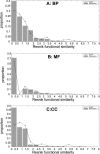Systematic analysis of head-to-head gene organization: evolutionary conservation and potential biological relevance
- PMID: 16839196
- PMCID: PMC1487180
- DOI: 10.1371/journal.pcbi.0020074
Systematic analysis of head-to-head gene organization: evolutionary conservation and potential biological relevance
Erratum in
- PLoS Comput Biol. 2006 Aug;2(8):e112
Abstract
Several "head-to-head" (or "bidirectional") gene pairs have been studied in individual experiments, but genome-wide analysis of this gene organization, especially in terms of transcriptional correlation and functional association, is still insufficient. We conducted a systematic investigation of head-to-head gene organization focusing on structural features, evolutionary conservation, expression correlation and functional association. Of the present 1,262, 1,071, and 491 head-to-head pairs identified in human, mouse, and rat genomes, respectively, pairs with 1- to 400-base pair distance between transcription start sites form the majority (62.36%, 64.15%, and 55.19% for human, mouse, and rat,respectively) of each dataset, and the largest group is always the one with a transcription start site distance of 101 to 200 base pairs. The phylogenetic analysis among Fugu, chicken, and human indicates a negative selection on the separation of head-to-head genes across vertebrate evolution, and thus the ancestral existence of this gene organization. The expression analysis shows that most of the human head-to-head genes are significantly correlated,and the correlation could be positive, negative, or alternative depending on the experimental conditions. Finally, head to-head genes statistically tend to perform similar functions, and gene pairs associated with the significant cofunctions seem to have stronger expression correlations. The findings indicate that the head-to-head gene organization is ancient and conserved, which subjects functionally related genes to correlated transcriptional regulation and thus provides an exquisite mechanism of transcriptional regulation based on gene organization. These results have significantly expanded the knowledge about head-to-head gene organization. Supplementary materials for this study are available at http://www.scbit.org/h2h.
Conflict of interest statement
Figures





Similar articles
-
Naturally occurring antisense: transcriptional leakage or real overlap?Genome Res. 2005 Mar;15(3):364-8. doi: 10.1101/gr.3308405. Epub 2005 Feb 14. Genome Res. 2005. PMID: 15710751 Free PMC article.
-
Sorting out inherent features of head-to-head gene pairs by evolutionary conservation.BMC Bioinformatics. 2010 Dec 14;11 Suppl 11(Suppl 11):S16. doi: 10.1186/1471-2105-11-S11-S16. BMC Bioinformatics. 2010. PMID: 21172051 Free PMC article.
-
Pan-Cancer Analysis of Head-to-Head Gene Pairs in Terms of Transcriptional Activity, Co-expression and Regulation.Front Genet. 2021 Jan 7;11:560997. doi: 10.3389/fgene.2020.560997. eCollection 2020. Front Genet. 2021. PMID: 33488665 Free PMC article.
-
Comparative analysis of processed pseudogenes in the mouse and human genomes.Trends Genet. 2004 Feb;20(2):62-7. doi: 10.1016/j.tig.2003.12.005. Trends Genet. 2004. PMID: 14746985 Review.
-
Base composition and gene distribution: critical patterns in mammalian genome organization.Trends Genet. 1996 Dec;12(12):519-24. doi: 10.1016/s0168-9525(97)81400-x. Trends Genet. 1996. PMID: 9257535 Review.
Cited by
-
Tissue-specific activation of gene expression by the Synergistic Activation Mediator (SAM) CRISPRa system in mice.Nat Commun. 2021 May 13;12(1):2770. doi: 10.1038/s41467-021-22932-4. Nat Commun. 2021. PMID: 33986266 Free PMC article.
-
COL4A3 expression in asthmatic epithelium depends on intronic methylation and ZNF263 binding.ERJ Open Res. 2021 Jun 7;7(2):00802-2020. doi: 10.1183/23120541.00802-2020. eCollection 2021 Apr. ERJ Open Res. 2021. PMID: 34109240 Free PMC article.
-
A plant cell death-inducing protein from litchi interacts with Peronophythora litchii pectate lyase and enhances plant resistance.Nat Commun. 2024 Jan 2;15(1):22. doi: 10.1038/s41467-023-44356-y. Nat Commun. 2024. PMID: 38167822 Free PMC article.
-
Transcription factor binding and modified histones in human bidirectional promoters.Genome Res. 2007 Jun;17(6):818-27. doi: 10.1101/gr.5623407. Genome Res. 2007. PMID: 17568000 Free PMC article.
-
A small intergenic region drives exclusive tissue-specific expression of the adjacent genes in Arabidopsis thaliana.BMC Mol Biol. 2009 Oct 16;10:95. doi: 10.1186/1471-2199-10-95. BMC Mol Biol. 2009. PMID: 19835620 Free PMC article.
References
-
- Bressan A, Somma MP, Lewis J, Santolamazza C, Copeland NG, et al. Characterization of the opposite-strand genes from the mouse bidirectionally transcribed HTF9 locus. Gene. 1991;103:201–209. - PubMed
Publication types
MeSH terms
LinkOut - more resources
Full Text Sources

